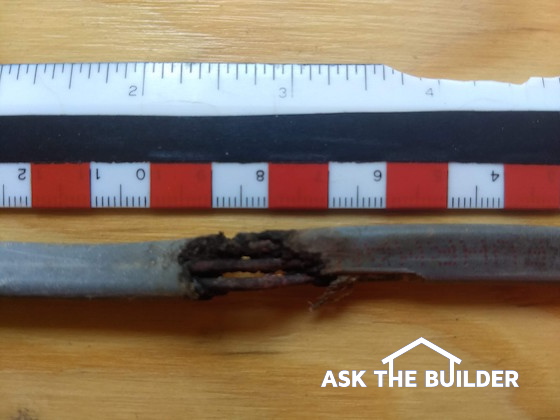Burying Electrical Wire

Burying Electrical Wire | Here’s a piece of shorted electrical cable pulled from the ground. It caused arcing house wiring in my yard. It was rated for direct burial and was damaged by frost movement in the soil. (C) Copyright 2021 Tim Carter
Burying Electrical Wire - It's Allowed, But Use Conduit
QUESTION #1: Tim, can you settle a debate between me and my wife? We have to have electric cables buried in the ground for all sorts of things around our home. She insists on putting the cables in conduit and I say, after doing online research, that the use of code-approved cable for direct burial is good enough. I’ll add that we live in a colder climate where the ground does freeze all winter if that makes a difference. Brad P., Burlington, VT
I hate getting involved in these marital battles. More often than not, I tend to side with the wife because women seem to apply more critical thinking skills to the conundrums. Perhaps that’s why they live longer too!
Brad’s wife is on the right side of this issue in my opinion. I defer to a personal encounter I had at my own home with buried underground electrical cables. It’s very important to realize the house I currently live in was built by someone else, not me.
CLICK or TAP HERE to get FREE BIDS from local electricians who can bury electric wire.
Why Does My Post Lamp Not Work?
This past spring, I discovered that the post lamp at the end of our driveway no longer turned on. I checked and the circuit breaker had tripped. I went to reset the breaker and it immediately popped indicating a dead short in the circuit. Dead shorts are bad.
How Do You Discover the Broken Wire?
While not a master electrician, I’ve done lots of residential wiring to code and I knew how to quickly isolate the sections of the circuit to determine the location of the short. Within minutes I discovered the short was in a section of wire that was buried between the corner of the garage and an oak tree where an above-ground junction box was located.
Where Was the Short?
Fast forward and the short was at the end of a single piece of PVC conduit that the builder, or his electrician, had placed under our blacktop driveway. No conduit was used anywhere else, just under the driveway. The wire exited one end of the conduit and made a sharp turn. The up and down movement of the frost action here in New Hampshire had rubbed the plastic insulation off the cable where it contacted the sharp edge of the PVC conduit.
Do Rocks Move in Soil?
Sharp rocks are brought to the surface slowly by frost action. They can cut into unprotected wire and cable even though it’s rated for direct burial. Garden spades, shovels, and deep-cutting roto-tillers can chop into unprotected cables. Conduit prevents damage from almost all of these accidents.
I shared my woeful tale back in the spring about my shorted electric cable in my AsktheBuilder newsletter. One of my subscribers who lives in northern Maine shared how his electrician protects underground electrical cables.
Can Conduit Cause Problems?
This older master electrician discovered that conduits in deep cold climates can be problematic for a host of reasons. He experimented years ago digging a 2-foot-wide trench and putting in one foot of sand in the bottom. He’d then lay the wire in a zig-zag fashion on the sand to allow for movement. The cable would then be covered with another foot of sand. My subscriber claims the electrician has never had a failure putting in buried electric cable this way.
Should Conduit Be Used in Warm Climates?
Those who live in warmer climates where soil frost isn’t an issue should always bury cables in conduit in my opinion. Code-approved PVC conduit is affordable. It’s easy to install and comes with pre-bent fittings allowing you to go around tighter corners.
Should I Photograph and Video Conduit Before Covering It?
Should you decide to use conduit around your home always take photos of where it is before you cover the conduit with soil. If your digital photos are stored online, create a public album and place the URL to it on a piece of paper that you put in a zip-lock sandwich bag next to your circuit breaker panel. Mark on it: PHOTOS of BURIED EXTERIOR CONDUIT.
Believe me, a future homeowner, contractor, or electrician will thank you profusely for these photos showing where the wires snake about under your lawn, driveway, and gardens.
Should Large Blank Conduit Be Under Pavement?
While you’re at it, be sure to install sections of larger conduit, no less than 2 inches in diameter, under sidewalks, driveways or other paved surfaces. You may not need to run a cable now, but believe me, it’s so nice to know you can go under a paved surface with ease in the future. Make note of these conduit locations and put that drawing in the same sandwich bag next to the electrical panel.
Follow the NEC
Another key point is to follow the National Electrical Code with respect to all provisions dealing with conduit and the required depth of burial. Even though you bury the cables the recommended depth, they can be damaged by an inexperienced equipment operator. The key, in my opinion, is to have a clear record of exactly where all underground cables are buried on your land.
Column 1312